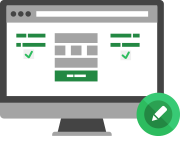Certificate in Cash Flow and Forecasting

Introduction
This course will encompass a thorough walkthrough of cash flow from the cash drivers of different businesses to the cash from operations and free cash flow. The importance of understanding the accounting cash flow statement prepared for financial statements will be covered in detail. Delegates will be taken through the derivation of free cash flow and how it can be used in both corporates and banks. Cash flow ratios will be developed and used in order to verify and check cash flow calculations.
The second part of the course will cover the forecasting of cash flows, using the knowledge gained in the first part of the course. The process of forecasting the cash flow will be based on using assumptions and historical figures, the forecast income statement and forecast balance sheet. The end result will be a fully balancing set of forecast financials with a cash flow forecast. The course will include numerous cash flow forecasts’ templates for different types of businesses.
Key business benefits
- Review figures of selected international companies and highlight the differences between profits and cash;
- Analyse major companies’ cash flows;
- Review different companies’ cash flows and identify potential problems;
- Prepare interpretation of numerous cash flow statements;
- Evaluate the drivers of cash flow of numerous companies;
- Prepare a simple forecast model to incorporate seasonality.
Skills Acquired
- Comparison of different cash flows;
- Compare debt capacity and cash flow in a corporate;
- Analyse cash flow ratios versus traditional financial ratios;
- Construct a cash flow statement ǽ Prepare a detailed cash budget;
- Prepare a detailed cash budget;
- Build a forecast model and incorporate debt service capacity.
Learning objectives
- Interpret cash flow statements and ratios, and identify positive and negative corporate performance;
- Appreciate why cash flow analysis is more important than balance sheet and income statement analysis;
- Evaluate free cash flow and the ability of companies to meet their financial commitments;
- Use the latest computer spread sheet formats in projecting cash flow.
Day 1
Session 1: Accounting For Cash
- Difference between cash and profit;
- Cash inflows;
- Cash outflows;
- The cash conversion period;
- Accruals and non-cash items.
Session 2: The Cash Flow Statement
- A tool for analyzing sources and uses of cash;
- The published and the derived cash flow statement;
- Accounting standard;
- Exercise: Prepare interpretation of numerous cash flow statements.
Session 3: Constructing the Cash Flow Statement
- From the books of accounts – The accountancy method;
- From the balance sheet and income statement – The banking method;
- Case Study: Construct a cash flow statement.
Session 4: Analyzing Historic Cash Flow Statements
- Structure of cash flow statements;
- Profitability measures ;
- Working investment management;
- Investment decisions – impact of capital expenditure, acquisitions and disposals;
- Funding decisions;
- Different drivers in different businesses;
- Relating cash flows to loan repayment;
- Case Study: Review selected international companies’ cash flow.
Session 5: Cash Flow Ratios
- Calculating and understanding cash flow ratios;
- Cash flow ratios as a predictive tool – success versus distress;
- The use of cash flow ratios as loan covenants;
- Case Study: Analyze cash flow ratios versus traditional financial ratios (selected corporates).
Session 6: Understanding the Priority of Cash Flows
- Earnings Before Interest, Taxes, Depreciation, and Amortization (EBITDA);
- Operating cash flow and free cash flow;
- Lumpy and volatile cash flows;
- Allocating available cash to appropriate resources;
- Debt capacity and structure;
- Case Study: Compare debt capacity and cash flow in a corporate.
Session 7: Analyzing Complex Cash Flows
- Looking at cash flows in conglomerate companies;
- Understanding typical cash flows in different businesses;
- Spotting creative accounting situations;
- Cash flows in groups – inter-company trading;
- Exercise: Analyze major companies’ cash flows.
Day 2:
Session 8: Identifying Cash Flow Problems
- The benefits of up-to-date forecasting;
- Watching the market closely for changes;
- Signs that your customers are in difficulty;
- How to avoid cash flow problems;
- Exercise: Review different companies’ cash flows and identify potential problems.
Session 9: Cash Budgets
- Cash inflows;
- Accounts receivable;
- Average collection period;
- Accounts receivable to sales ratio;
- Accounts receivable ageing;
- Cash outflows;
- Accounts payable ageing schedule;
- Case Study: Prepare a detailed cash budget.
Session 10: Key Concepts Financial Forecasting
- Types of forecasts and their uses;
- Simple statements of when funds are due;
- Hard copy schedules provided;
- Simple Excel based ‘direct’ cash forecasts;
- Comprehensive Excel based ‘indirect’ methods;
- Professionally developed multi-tab Excel models;
- Appropriate financial forecast models;
- Understanding credit risk;
- Mapping the type of forecast to the underlying industry;
- Sources of information;
- Exercise: Evaluate the drivers of cash flow of numerous companies;
- Business model;
- Business risk;
- Sustainability of sales;
- Predictability of sales;
- Volatility;
- Seasonality;
- Cycles;
- Industry risk;
- Competitiveness;
- Benchmarking;
- Exercise: Prepare a simple forecast model to incorporate seasonality.
Session 11: Forecasting Cash Flow
- The key cash drivers;
- Looking at historical cash flows as a basis for future cash flow;
- Using value drivers to make decisions on future business profiles;
- Working with uncertainty – sensitizing within a range of possibilities;
- Use of sensitivity analysis and simulations;
- General principles on the structure of cash flow projections;
- Cash Flow Available for Debt Service (CADS);
- Debt capacity – debt service capacity as a key indicator of risk;
- Projections – short, medium and long-term;
- Case Study: Build a forecast model and incorporate debt service capacity.
Session 12: Cash Flow, Income Statement and Balance Sheet
- A model will be loaded on your PC to enable you to use historical information as a basis for forecasting;
- You will input assumptions about value drivers;
- The resulting forecasts will then be used to answer a number of questions about the company’s borrowing and repayment capabilities and the need for extra security on any financing.
Session 13: Building the Forecast
- Assumptions
- Revenue forecast and growth – decompose sales
- Cost of goods sold – decomposing
- Inflation – real versus nominal
- Revenues and costs; the level of fixed and variable costs
- Income Statement:
- Balance Sheet
- Cash Flow Forecast
- Using the Forecast
Session 14: Summary and Close
- Course Review
- Evaluation
Andre Lanser
Credit, Corporate Finance and Financial Modelling
Andre Lanser is a consulting trainer as well as a corporate finance practitioner and he has delivered courses around the world in the areas of Credit, Corporate Finance, Valuation and Financial Modelling both for Corporates and Banks.
Andre originally qualified as a Chartered Accountant, completing articles with PricewaterhouseCoopers. He started his career with a subsidiary of Commercial Union, involved in the steel manufacturing industry.
His experience ranged from systems implementation, credit assessment of the highly risky construction industry customers, heading up the finance functions to successfully turning the business around and then selling the company through a trade sale.
Later he joined Commercial Union in the investment back-office function, reengineering the investment back office and later headed-up a team who implemented a new investment management system for both the back office and the front office.
His commercial experience includes restructuring and turning around a Steel Manufacturing operation, consulting to a Pharmaceutical company involved in medical devices for both Government and Private Hospitals and an in depth knowledge of the citrus industry, consulting to South African Airways and extensive work at Hanover Acceptances property company, Dorrington in London.
His career then spanned over 15 years in the Venture Capital and Private Equity arena, where he has gained a vast amount of experience in the corporate analysis and valuation field.
He is a specialist in developing and training finance related courses, including corporate credit related topics, credit analysis and cash flow analysis with a special focus on the banking sector, derivatives, and financial modeling courses. His training experience spans a period of more than 15 years.
Online Purchasing Instructions


Choose a product and add it to the cart

Add more products or proceed to checkout

Fill in all the information and finalize the order

Check your email for confirmation and details
